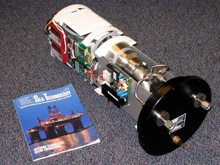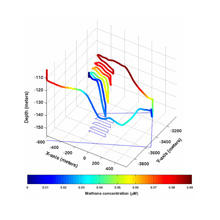The HCMR Thetis human occupied submersible will be used during the 2006 PHAEDRA project. The Gemini Mass Spectrometer instrument will operate onboard the Thetis submersible and its data will help guide surveys in real-time, allowing the scientists to rapidly locate and generate detailed maps of chemical features. Click image for larger view and image credit.
Chemical Sensing
Rich Camilli
Co-Principal Investigator
Until recently it was assumed that areas of the deep ocean, below where sunlight reaches, were probably the most boring places on Earth. How could anything important be happening in a place where everything is constantly soaking in seawater, the temperature is always just barely above freezing, and photosynthesis cannot occur? There is no day light, just cold eternal darkness and ambient water pressure high enough to instantly kill a person. For many years these areas of the Earth's oceans were considered to be “dead zones” because it was thought that nothing changed and nothing could live there. However, it was not until we looked that we discovered otherwise.
We now know that even in these forbidding environments, the geologic processes can often be highly dynamic and serve as oases for bizarre life forms which thrive there. Beginning in the late 1970s, scientists found the first evidence that life could function by deriving energy directly from the earth’s chemistry, without requiring photosynthesis in any segment of the food chain. These creatures, known as chemosynthetic organisms, are able to utilize highly toxic chemicals such as hydrogen sulfide for energy. In recent years the unique enzymatic capabilities of these organisms have been harnessed for medical and industrial uses, ranging from genetic testing to the development of high temperature laundry detergents.
Much work remains to be done. Most of the Earth's oceans remain uncharacterized because unlike terrestrial and atmospheric science, we can not use earth observing satellites to investigate the deep ocean. Therefore, to study this part of the Earth we must either collect samples for laboratory-based study, or we must observe the environment in-situ. Until recently, in-situ biogeochemical investigation of marine environments was technologically unfeasible. In-situ investigation remains very challenging, but is now possible through the use of advanced chemical sensors operating aboard submersible platforms. Several chemical sensors we will use for the 2006 PHAEDRA expedition have been developed specifically for in-situ marine deployment, and are similar to those used by space probes for interplanetary exploration.
One of the newly developed chemical sensors that will be used for the PHAEDRA expedition is the Gemini mass spectrometer, which was developed at the Woods Hole Oceanographic Institution. This instrument is capable of quantitatively identifying a broad spectrum of chemical compounds and their isotopes, allowing the scientists to “fingerprint” complex chemical signatures in the sediments and water column. Mass spectrometers have been used on space probes such as the Mars Viking Lander and Jupiter Galileo probe to explore these planets and search for evidence of life. The Gemini instrument, which is designed specifically for use onboard underwater vehicles, will operate onboard the HCMR Thetis submersible and its data will help guide surveys in real-time, allowing the scientists to rapidly locate and generate detailed maps of chemical features such as active venting from inside the Columbo volcano’s crater.
Until now oceanographers have utilized only rudimentary tools such as cameras and temperature probes to locate vent features. By using new technologies such as Gemini, the expedition scientists will be able to better characterize these chemical features, providing new insight into deep earth processes. The geochemical data gathered by these instruments will allow geologists to compare chemical characteristics of the Columbo volcano and neighbouring hydrothermal sites with other active sites in the Hellenic Volcanic Arc system, and throughout the world. These data will also indicate what types of biochemical pathways are available and if these pathways are being used, providing clues whether chemosynthetic organisms or other types of life are present. These technologies can also be applied to underwater archaeology, providing useful information about the types of materials present at a shipwreck site, as well as their preservation state.Sign up for the Ocean Explorer E-mail Update List.




















